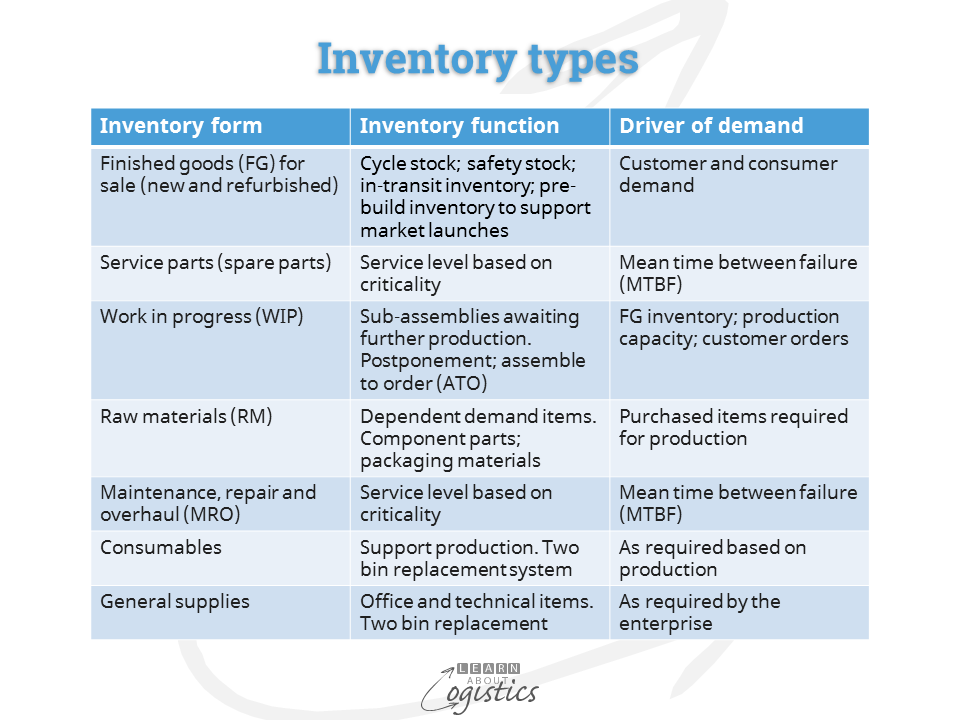Inventory as a core requirement.
Projects and campaigns have occurred in some businesses concerning reduction of inventory, notably those concerned with Just in Time (JIT) and its later incarnation, ‘Lean’. But overall, the investment in inventories within a supply chain does not disappear. So, to manage inventories in your organisation is a key responsibility of Logisticians; in association with other supply chain professionals in Procurement and Operations Planning.
It is unfortunate that within a business, the accounting system considers inventories an asset, while Logisticians consider inventories as a necessary liability – to be minimised. These different views may help to explain why more enterprises do not have Inventory Management as a core consideration within their supply chain structure and strategy.
Inventory is the term used for a variety of status of materials:

The total amount of inventory and its performance measurement against activities like sales volumes is governed by the Uncertainty in a supply chain. Uncertainty is affected by an increasing desire for responsiveness in demand markets, the length of supply chains and the internal and external levels of complexity, variability and constraints in supply markets. This causes Instability in an organisation’s Supply Network, measured on the demand side by increasing variability in the sales forecast ‘error’ and inability to meet the delivery requirement of ‘In Full, On Time, with Accuracy’ (DIFOTA). Uncertainty and Instability in any endeavour requires a ‘Just in Case’ response, which in Logistics is typically to hold higher inventories.
However, the role of a Logistician (as noted in the 2018 introductory blog) is “To meet Availability (DIFOTA) objectives by reducing Uncertainty and increasing strategic advantage, through understanding the range of external complexity, variability and constraints affecting the organisation and reducing internal uncertainties caused by the conflicting objectives of corporate functions”.
But, to achieve this objective requires a structured approach. The first step in the process is for Inventory Management to be seen in three parts:
- Inventory policy: measured at the corporate level, to identify the money which the enterprise is willing to invest in inventory, based on an evaluation of the physical options. Development of the Policy is the responsibility of the senior supply chain executive, for approval by the Board
- Inventory planning: measured at the product or family group level and undertaken by Operations Planning (or similar titled group). The Inventory Policy is used as the control function in Planning
- Inventory control: the measure of actual against planned inventory, counted at the stock keeping unit (SKU) level and undertaken at each location
Of these, it is Inventory Policy that establishes the rules and limits of managing inventory.
Inventory policy analysis
The three core sections of the analysis are to identify where inventories:
- Should be held – the Location:
- centralised or decentralised locations (the latter is more likely for an enterprise offering on-line ordering and quick home delivery);
- customers and demand channels that could be served from each location
- company owned and leased premises
- customer locations
- supplier distribution centre or warehouse
- third-party managed location
- centralised or decentralised locations (the latter is more likely for an enterprise offering on-line ordering and quick home delivery);
- In what form: raw and packaging materials, part and semi-finished goods, finished goods and
- For what function: cycle stock, safety stock, in-transit inventory, pre-build inventory to support market launches, slow and obsolete (SLOB) inventory required by Sales
For a Consumer Packaged Goods (CPG – controlled by ‘use by’ date) or Fast Moving Consumer Goods (FMCG) business, the finished goods distribution inventory is provided from items that are: make to stock, assembled to order (with or without postponement) or make to order. The mode will define decisions concerning the Form and Function of inventory at each node in the ‘core’ supply network.
To enhance the analysis, the following should also be evaluated and analysed:
- The Terms and Conditions (T&Cs) in contracts that influence the ‘location’ and ‘what form’ decisions – Vendor Managed Inventory (VMI) terms, full trucks, pallet heights etc.
- Supply execution visibility, to identify upstream disruptions: The actual Lead Times from suppliers and the measure of lead time variability. The longer the lead time, more inventory must be held; the higher the variability, the more safety inventory must be held to guard against stock-outs. This situation can be minimised, if ownership of the items is taken at the point of dispatch for the item. The inventory for the item then becomes a part of the buying organisation’s ‘moving and tracked’ warehouse assets, but the enterprise incurs the costs of moving the items. This can also be done by customers.
- The sales gross margin by product group and the contribution margin (sales less direct material and labour inputs). This provides input to the relationship between revenue, lost sales and the required inventory investment
- Supply markets intelligence base: Long supply chains with multiple levels of suppliers require an intelligence base of critical nodes and links in a supply network. Level 3 or 4 suppliers may provide critical materials in the process, but can stop or delay supply to level 2 or 3 suppliers, due to a natural disaster, labour dispute, or financial problems – all without your knowledge
The outcome from the analysis will be the physical inventories required under the current supply chain strategy (which is the collation of Procurement, Operations Planning and Logistics strategies). The physical inventories will be converted by Finance to a financial target. If the financial investment target is exceeded, a change is required to the supply chain strategy (which includes the customer service policy) and a re-calculation of the inventory investment.
Inventory Management is not a ‘set and forget’ activity – it is a critical part of your organisation that requires a Policy to support effective Planning and Control activities and that requires the expertise of Logisticians.

